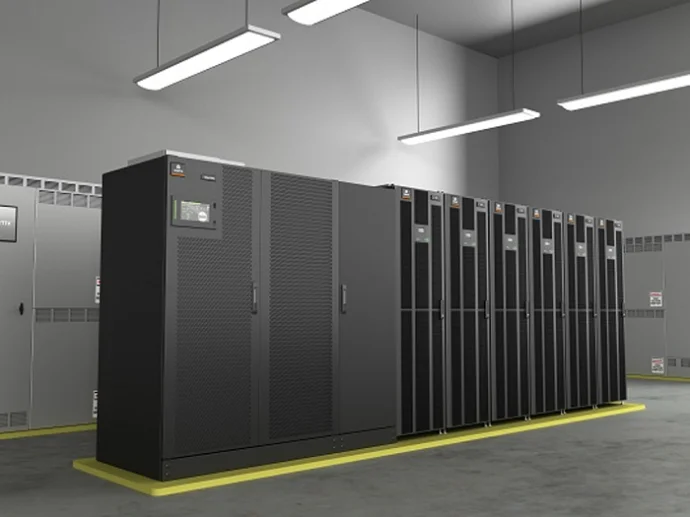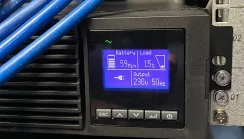Planning An Upgrade To A UPS Installation
Today it is not uncommon for an IT server network to have one or more uninterruptible power supplies. The UPS may have been installed as part of the original network rollout or added as the IT system was expanded. At some point during their working life a decision must be taken as to whether to opt for full UPS installation refurbishment or a complete system upgrade.
Centralised v Decentralised UPS Systems
A centralised uninterruptible power supply installation is one where a single UPS system provides power and protection to the entire IT network. The UPS may be a single phase or three phase system and will supply power to the electrical distribution network that the IT servers and network devices are plugged into, either directly or via power distribution units.
A decentralised power protection plan is one where individual UPS systems are deployed at various positions within the IT network. Typical examples include when a new server rack is installed, requiring its own rack mount protection or new Internet of Things (IoT) devices are deployed say within a factory or remote setting that require a small wall mount, tower or rack mount UPS to sit inside a data cabinet.
These types of UPS install arrangement will require slightly different upgrade plans given their distributed power architecture. A centralised UPS may be easier to manage from a maintenance contract and monitoring perspective but more fixed in capacity than a distributed plan.
Network Downtime and UPS Bypass Switches
A UPS bypass switch is also referred to as a UPS maintenance bypass switch and is a recommended accessory. The bypass switch allows the UPS to be bypassed and safely maintained without disruption to the connected loads.
Some UPS include an internal bypass, but the external device provides for full electrical isolation and the opportunity to remove the UPS completely from the electrical circuit.
With a UPS maintenance bypass switch ‘in situ’ a UPS can be safely removed for refurbishment or swap out without the need for IT network and server downtime. This type of installation arrangement is more likely with a centralised UPS system install. Decentralised UPS may not have been installed with this facility.
If the installed system does not have a bypass arrangement, our projects team will recommend one to prevent future disruption and future-proof the system.
UPS Technology Upgrades
UPS manufacturers upgrade their technologies on a regular basis. A typical online UPS range may be in manufacture for 5-10 years with new systems launched to take advantage of developments in power electronics and system architectures.
If the server room, datacentre or industrial application is running a UPS installed 10-15 years ago then it may well be a transformer-based system. Whilst a very robust system for its time, the uninterruptible power supply runs at low energy efficiencies (80-85%) compared to modern systems which can achieve up to 97% in online mode.
A more modern online transformer-based UPS could have a ‘high efficiency’ transformer and IGBT-based rectifier ensuring the UPS uses less energy and presents a near-to-perfect sinusoidal waveform to the mains power supply or generator and therefore less power pollution.
Transformer-less online UPS systems have also evolved over the last 10 years. The systems will also use an IGBT-based rectifier in place of the traditional 12-Pulse or 6-Pulse system that required harmonic filters for sites with very sensitive servers and electronic devices. Other improvements include a more efficient and higher switching band inverter with reduced noise output, advantage battery management to help prolong battery set working lifetimes and the ability to maintain a high operating efficiency over a wider load range from as low as 20% to 100% load i.e. a fairly flat load power curve.
In the last 5 years modular UPS systems have become one of the largest growth sectors for installations requiring a scalable architecture. Based on transformer-less technology, modular systems provide a range of frame sizes into which standard UPS modules can be deployed (typically 25-50kW) to provide N+X redundancy and power upgrade.
With a Monoblock UPS design, N+X redundancy and scalability can be achieved but with the addition of a rating-matching system. For a 100kVA UPS this means adding another 100kVA UPS into the installation with parallel card connectivity (Master-Slave) between the two and a common shared battery or individual battery sets. In a modular UPS rated at 100kW, an additional 50kW UPS modules provides N+1 and the UPS frame size may allow for up to 4-5 modules into total i.e. 200-250kW capacity for future load expansion.
Energy Efficiency and Carbon Footprints
A higher UPS operating efficiency results in lower operating costs and lower demands placed on the cooling systems in server rooms and datacentres. Improving battery life expectancy can also lower the total cost of ownership (TCO) and reduce environmental impact.
An online UPS for a server room or datacentre application may have 5year or 10year design life lead acid batteries which will require replacement around years 3-4 or 7-8. Advanced UPS battery management features may help to improve the working life expectancy of the battery set using appropriate charging techniques and features including charger sleep mode; where the battery can self-discharge to a pre-set threshold before the charger re-engages. Self-discharge is a natural phenomenon of a lead acid battery. Turning the battery charger off improve energy efficiency and may help to improve the life of the battery.
The batteries in a UPS are a consumable item and are automatically tested by the UPS every 24hours. The UPS will use an algorithm to test and monitor the results for the complete battery set. The UPS system should also be subject to regular (at least one a year) preventative maintenance. During this visit, individual battery block testing and comparison to previous results can help to identify and track block performance issues. In a well maintained and stable ambient (20-25˚C) it may be possible to delay battery replacement by 12-18months and so reduce the carbon footprint of the entire UPS installation.
Energy Technology List for UPS Systems
The rise in UPS operating efficiency had several drivers including the need to be more eco conscious. Many UPS manufacturers now offer high efficiency systems, and several are listed on the Energy Technology List.
The Energy Technology List (ETL) is a government-managed list of energy efficient systems that form part of the Enhanced Capital Allowance (ECA) tax scheme for UK businesses. ETL approved UPS are rated for their energy efficiency across several load bands.
More information: https://www.gov.uk/government/publications/energy-technology-list-information-leaflet-uninterruptible-power-supply
Lead Acid or Lithium-ion Batteries
Most UPS manufacturers now offer lithium-ion battery set alternatives. This type of battery can be used to change the backup power profile of the UPS system from ‘standby’ to ‘energy storage’.
Lithium-ion batteries are more temperature tolerant and capable of faster and a higher number of charge/discharge cycles. In energy storage mode, the UPS system still provides standby backup but with the added advantage of allowing the battery set to be charged from a local renewable power source (solar PV or wind turbine) or being charged overnight at low-rate electricity tariffs for discharge during the day. The latter allows a UPS system load to form part of the National Grid’s demand side response program for stabilising grid Frequency and boosting the overall electricity supply available.
More information: https://www.nationalgrideso.com/balancing-services/demand-side-response-dsr
Future Recycling Plans
Business and society at large are being asked to consider the future environmental impact of their investments and activities. At present over 90% of a lead acid battery can be recycled and there are well established companies offering recycling services. The plastic cases, lead plates and electrolyte can be recovered for repurposing either in new batteries or alternative products.
Lithium-ion (Li-ion) batteries cannot be as easily recycled and there is only one major recycling centre, based in The Netherlands. However the planned increase in electric vehicle (EV) and home and grid-scale energy storage (which are both dependent upon Li-ion batteries) will lead to more recycling options and plants in the future. Future recycling should not prevent the move to a lithium-ion battery-based UPS system if the system fits the installation requirements, even if the batteries do currently have a 20-30% premium over lead acid ones.
Electrical Installation Infrastructures
Of course any planned UPS system upgrade or install will require a review of the electrical distribution within the building and server room or datacentre by a certified electrical contractor.
The electrical infrastructure may need upgrading if the size of UPS system to be installed increases. Attention should also be given to upstream circuit breaker sizing and discrimination (for potential short circuits) as well as downstream power distribution.
UPS System Installations Checklist
In summary there are at least eight factors that should be considered when looking at how best to install an uninterruptible power supply. This list is generic and for specific sites there will be other factors to cover in the discovery and planning stages.
- Centralised or decentralised UPS
- UPS bypass switch arrangements
- Monoblock or modular UPS technologies
- Energy efficiency and carbon footprint
- Energy Technology List capital allowances
- Lithium-ion v lead acid UPS batteries
- Future Recycling Plans
- Electrical infrastructure and distribution

























